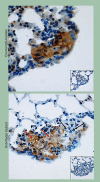Nodal as a biomarker for melanoma progression and a new therapeutic target for clinical intervention
- PMID: 19885369
- PMCID: PMC2682534
- DOI: 10.1586/17469872.4.1.67
Nodal as a biomarker for melanoma progression and a new therapeutic target for clinical intervention
Abstract
Nodal, an embryonic morphogen belonging to the TGF-β superfamily, is an important regulator of embryonic stem cell fate. We have recently demonstrated that Nodal is expressed significantly in aggressive melanoma. Surprisingly, expression of the Nodal coreceptor, Cripto-1, was detected in only a small fraction of the melanoma tumor cell population, indicating a primary role for Cripto-1-independent signaling of Nodal in melanoma. In this review, we discuss how regulatory factors present in an embryonic environment, such as Lefty, can downregulate Nodal expression and inhibit tumorigenicity and plasticity of melanoma cells. Our translational studies show that antibodies against Nodal are capable of repressing melanoma vasculogenic mimicry and of inducing apoptosis in melanoma tumors in an in vivo lung-colonization assay. Our previous work and ongoing studies suggest that Nodal may represent a novel diagnostic marker and therapeutic target in melanoma.
Figures







References
-
- Tsao H, Atkins MB, Sober AJ. Management of cutaneous melanoma. N. Engl. J. Med. 2004;351(10):998–1012. - PubMed
-
- Clark WH, Jr, Elder DE, Guerry D, 4th, et al. A study of tumor progression: the precursor lesions of superficial spreading and nodular melanoma. Hum. Pathol. 1984;15(12):1147–1165. - PubMed
-
- Moan J, Porojnicu AC, Dahlback A. Ultraviolet radiation and malignant melanoma. Adv. Exp. Med. Biol. 2008;624:104–116. - PubMed
-
- Collisson EA, De A, Suzuki H, Gambhir SS, Kolodney MS. Treatment of metastatic melanoma with an orally available inhibitor of the Ras–Raf–MAPK cascade. Cancer Res. 2003;63(18):5669–5673. - PubMed
-
- Haluska F, Pemberton T, Ibrahim N, Kalinsky K. The RTK/RAS/BRAF/PI3K pathways in melanoma: biology, small molecule inhibitors, and potential applications. Semin. Oncol. 2007;34(6):546–554. - PubMed
Website
-
- The Cancer Genome Anatomy Project: SAGE Anatomic Viewer (SAV) http://cgap.nci.nih.gov/SAGE/AnatomicViewer.
Grants and funding
LinkOut - more resources
Full Text Sources
Other Literature Sources
